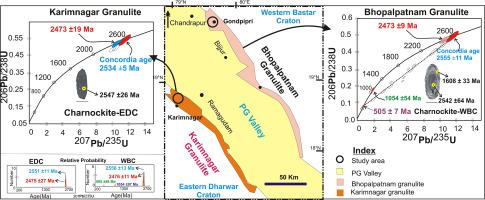Gondwana Research ( IF 7.2 ) Pub Date : 2021-01-07 , DOI: 10.1016/j.gr.2020.12.024 Tushar Meshram , M. Lachhana Dora , Srinivasa R. Baswani , Dewashish Upadhyay , Rajkumar Meshram , Kirtikumar Randive , Sameer Ranjan , Jayanta K. Nanda

|
Charnockites constitute an integral component of granulite belts exposed on the northern and southern flanks of the Godavari rift, which marks the contact between the Bastar and Eastern Dharwar cratons in peninsular India. In this study, we attempt to constrain the petrogenesis of granulites from Gondpipri, Bhopalpatnam on the northern flank and Karimnagar on the southern flank of the Pranhita-Godavari valley using petrography, mineral and whole-rock geochemistry, fluid inclusion studies, and U Pb zircon geochronology. The presence of relict magmatic textures and orthopyroxene chemistry is suggestive of an igneous protolith while CO2-rich fluid inclusions in quartz correspond to subsequent granulite-facies overprint. Geochemically, charnockites from both granulite belts are metaluminous, magnesian, and calc-alkaline, having similar Sr and Y concentrations, Rb/Sr, Sr/Y, LaN/SmN, GdN/YbN, and Eu/Eu* ratios, and positive Ba
Pb zircon geochronology. The presence of relict magmatic textures and orthopyroxene chemistry is suggestive of an igneous protolith while CO2-rich fluid inclusions in quartz correspond to subsequent granulite-facies overprint. Geochemically, charnockites from both granulite belts are metaluminous, magnesian, and calc-alkaline, having similar Sr and Y concentrations, Rb/Sr, Sr/Y, LaN/SmN, GdN/YbN, and Eu/Eu* ratios, and positive Ba Pb and negative Nb-Ta-Ti anomalies. Zircons in charnockites from both granulite belts furnish magmatic crystallization ages of ~2.5 Ga (U
Pb and negative Nb-Ta-Ti anomalies. Zircons in charnockites from both granulite belts furnish magmatic crystallization ages of ~2.5 Ga (U Pb isotope) and also record a metamorphic overprint at ca. 2473 Ma. The similarity in protolith composition and U
Pb isotope) and also record a metamorphic overprint at ca. 2473 Ma. The similarity in protolith composition and U Pb ages of zircons in charnockites on the northern and southern flanks of the Godavari rift suggest that they constitute a cogenetic and coeval suite emplaced at ~2.5 Ga in an undivided and continuous Palaeo-Mesoarchean landmass that included the Bastar and Eastern Dharwar cratons, possibly as a part of the Ur-supercontinent. This undivided landmass subsequently got split along the Pranhita-Godavari rift zone into the Bastar and Dharwar cratons. The rift valley eventually developed into a sedimentary basin hosting the Proterozoic and Gondwana Group of sediments sequentially, apparently separating the two cratons on the map.
Pb ages of zircons in charnockites on the northern and southern flanks of the Godavari rift suggest that they constitute a cogenetic and coeval suite emplaced at ~2.5 Ga in an undivided and continuous Palaeo-Mesoarchean landmass that included the Bastar and Eastern Dharwar cratons, possibly as a part of the Ur-supercontinent. This undivided landmass subsequently got split along the Pranhita-Godavari rift zone into the Bastar and Dharwar cratons. The rift valley eventually developed into a sedimentary basin hosting the Proterozoic and Gondwana Group of sediments sequentially, apparently separating the two cratons on the map.
中文翻译:

 在印度半岛上的Pranhita Godavari裂谷两侧的霞长石的岩石成因和U Pb年代学-Bastar和东部Dharwar Cratons之间的联系
在印度半岛上的Pranhita Godavari裂谷两侧的霞长石的岩石成因和U Pb年代学-Bastar和东部Dharwar Cratons之间的联系
霞诺岩构成了在哥达瓦里裂谷的北部和南部侧面暴露的花岗石带的组成部分,这标志着印度半岛上的巴斯塔尔岩与东部达瓦尔克拉通之间的接触。在这项研究中,我们试图通过岩石学,矿物和全岩石地球化学,流体包裹体研究以及U  Pb锆石,来限制Pranhita-Godavari谷北部侧翼Gondpipri,Bhopalpatnam和南部侧翼Karimnagar的花岗岩成岩作用。地球年代学。残余岩浆质地和邻二甲苯化学的存在暗示着火成原生质而CO 2石英中富集的流体包裹体对应于随后的花岗石相套印。在地球化学上,两个花岗石带的霞石都是金属,镁质和钙碱性的,具有相似的Sr和Y浓度,Rb / Sr,Sr / Y,La N / Sm N,Gd N / Yb N和Eu / Eu *比,正的Ba
Pb锆石,来限制Pranhita-Godavari谷北部侧翼Gondpipri,Bhopalpatnam和南部侧翼Karimnagar的花岗岩成岩作用。地球年代学。残余岩浆质地和邻二甲苯化学的存在暗示着火成原生质而CO 2石英中富集的流体包裹体对应于随后的花岗石相套印。在地球化学上,两个花岗石带的霞石都是金属,镁质和钙碱性的,具有相似的Sr和Y浓度,Rb / Sr,Sr / Y,La N / Sm N,Gd N / Yb N和Eu / Eu *比,正的Ba  Pb和负的Nb-Ta-Ti异常。两个花岗石带的霞石中的锆石提供了约2.5 Ga(U
Pb和负的Nb-Ta-Ti异常。两个花岗石带的霞石中的锆石提供了约2.5 Ga(U  Pb同位素)的岩浆结晶年龄,并且在ca处也记录了变质叠印。2473马。原生石成分与U的相似性
Pb同位素)的岩浆结晶年龄,并且在ca处也记录了变质叠印。2473马。原生石成分与U的相似性 戈达瓦里裂谷北侧和南侧侧斜角陨石中的锆石的Pb年龄表明,它们构成了约2.5 Ga处的同生和同时代套件,分布在一个未分割且连续的古美中古代陆块中,包括Bastar和东部Dharwar克拉通。乌尔超大陆的一部分。随后,这块未分割的陆地沿着Pranhita-Godavari裂谷带分裂成Bastar和Dharwar克拉通。裂谷最终发展成为一个沉积盆地,依次容纳了元古代和冈瓦纳群的沉积物,显然将地图上的两个克拉通分开了。
戈达瓦里裂谷北侧和南侧侧斜角陨石中的锆石的Pb年龄表明,它们构成了约2.5 Ga处的同生和同时代套件,分布在一个未分割且连续的古美中古代陆块中,包括Bastar和东部Dharwar克拉通。乌尔超大陆的一部分。随后,这块未分割的陆地沿着Pranhita-Godavari裂谷带分裂成Bastar和Dharwar克拉通。裂谷最终发展成为一个沉积盆地,依次容纳了元古代和冈瓦纳群的沉积物,显然将地图上的两个克拉通分开了。











































 京公网安备 11010802027423号
京公网安备 11010802027423号